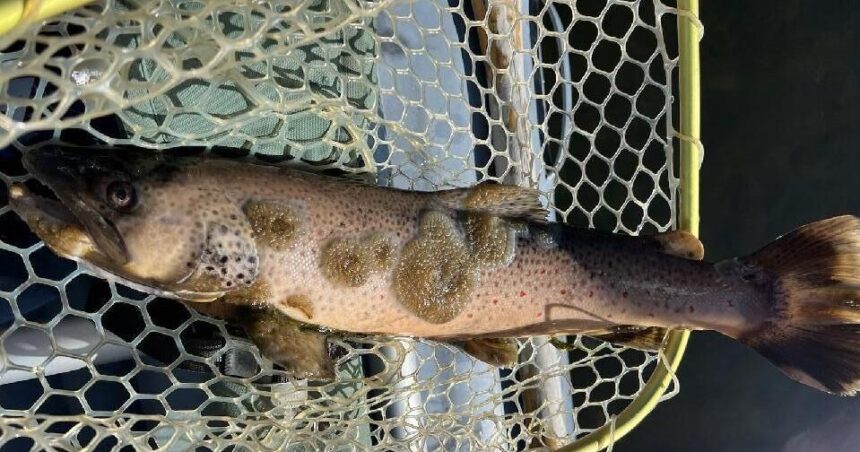Early Sunday, the Big Hole River’s popular fishing access site at Jerry Creek Bridge was deserted.
Montana Fish, Wildlife and Parks reports that water temperatures of 77 degrees Fahrenheit or more can kill trout.
On Aug. 2, the Big Hole Watershed Committee reported water temperatures in the river ranging from 71.6 degrees, in the section from Dickie Bridge to Maiden Rock, to 79.2 degrees from the Tony Schoonen access point to the Big Hole’s mouth.
The Aug. 6 flow at Melrose on Tuesday afternoon was 219 cubic feet per second, whereas the long-term median flow has been 441 cfs.
FWP added a new fishing closure Tuesday on the Big Hole from Saginaw Bridge on Skinner Meadows Road to the confluence with the North Fork of the Big Hole River.
But there was a glimmer of good news Tuesday tied to a water gage near Glen that had been providing inaccurate readings.
The U.S. Geological Survey gage, which has since been recalibrated, has suggested flows were worse than they’ve been.
In response, FWP revised an earlier closure and initiated hoot owl restrictions from the Big Hole’s confluence with the North Fork of the Big Hole to the Tony Schoonen Fishing Access site.
Shaun Jeszenka, owner of Frontier Anglers in Dillon, an outfitter and fishing guide, reacted.
“I applaud the FWP for recognizing that the data was incorrect and reopening the Big Hole,” Jeszenka said.
“The harsh reality is that these closures are becoming the norm rather than an emergency remedy,” he said. “This indicates a river system that is out of balance.”
Jeszenka hopes “everyone at the state level, from the governor’s office on down, will work to address mainstream flows in the Big Hole River rather than forcing the angling community and the fishery to suffer in the late summer on an annual basis.”
A freestone river is an undammed stream fed primarily by snowmelt and tributaries. Close observers of the Big Hole River — including outfitters, agencies, ranchers and others — worried that the paltry winter snowpack in the Jefferson River Basin would yield a challenging summer. And it has.
Wade Fellin co-owns the Big Hole Lodge near Wise River. He is a fishing guide, a board member of the Big Hole River Foundation and a co-founder of Save Wild Trout.
“For the first time in 40 years, we closed the lodge on July 12 due to extreme temperatures and our concern for the fish in the face of historic low populations and an unknown disease,” Fellin said Aug. 5.
“Water temperatures were in the 70s and only cooling to mid-60s at night,” he said. “We remain closed until conditions improve.”
Fellin has been vocal for years about his concerns regarding declining trout populations in the Big Hole River, the Beaverhead, the Jefferson and other rivers in the Jefferson River Basin. Population surveys this spring showed modest rebounds in some river reaches among brown and rainbow trout, but other sections still lagged long-term averages.
On Aug. 2, FWP announced the full length of the Jefferson River was closed to fishing due to low flows. That same day, the agency had announced the closure on the Big Hole from Dickie Bridge to the confluence with the Jefferson.
Data suggest the flows on the Big Hole are on par with 1931, 1988 and 2021.
In Aug. 1931, five men died fighting the Waldron Creek Fire west of Choteau. Wildfires in 1988 burned about 36 percent of Yellowstone National Park. That same year the Big Hole River was dry at Wisdom for 24 consecutive days.
And wildfires in 2021 burned tens of thousands of acres in southwest Montana.
The Big Hole Watershed Committee, or BHWC, formed in 1995 to help ranchers avoid the listing under the Endangered Species Act of the river-dwelling Arctic grayling by adopting voluntary conservation measures and restoration projects.
The BHWC’s website currently features a statement about flows.
“We’re making calls to irrigators to see what can be done — and many of them have already cut back or turned off. But it’s hot, dry and smoky out there, and there’s only so much water to go around.”
Pedro Marques, executive director of the watershed committee, has said conservation projects and voluntary cutbacks in irrigation won’t be enough to counter the effects of climate change. He has talked about the utility of water storage projects.
FWP reports that fishing restrictions and closures “are designed to protect fish that become more susceptible to disease and mortality when low flows and high-water temperatures combine with other stressors, including catch-and-release fishing.”
Fellin and others who have caught trout in recent years with lesions or obvious fungal infections have wondered what role disease has played and is playing with declining fish populations.
A July 31 news release from FWP said the agency has collected several tissue samples this summer from sick fish.
“Thus far, the sampling efforts have shown no abnormal results,” the agency said. “Anglers have reported fish with head lesions or fungal infections, but the causes of these maladies remain unknown.”
On Tuesday, Mike Duncan, FWP’s Region 3 fisheries program manager, was asked whether FWP has seen evidence of temperature-related fish kills.
“We’ve received several reports of a single or several dead or sick fish in the Big Hole, Beaverhead and Ruby rivers, which appear to be related to the head necrosis,” Duncan said. “We don’t know the cause of the infection. However, we typically observe or receive reports of minor infections in late spring or early summer before water temperatures reach concerning levels.
“Regardless, those were isolated events and not what I would characterize as a ‘fish kill’ or widespread, population-level event,” he added.
FWP has described ongoing plans to harvest fish tissue samples during monitoring efforts or when responding to reports of sick fish.
“Those samples will be evaluated by disease experts at Washington State University, Montana State University and the U.S. Fish and Wildlife Service,” FWP said.
The agency and Montana State University launched a cooperative effort last year to study fish mortality, recruitment and health. The researchers plan to publish next spring summaries of their work.
Meanwhile, Save Wild Trout and its partners continue to fund a Jefferson River Basin-wide water quality monitoring program shepherded by Kyle Flynn, PhD. The organization said Flynn plans to share preliminary results this fall.





